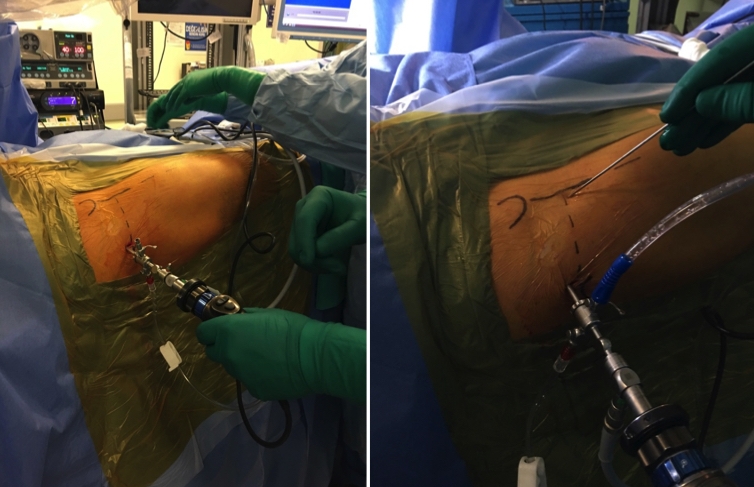Arthroscopic surgery is a surgical technique that enables the diagnosis and treatment of orthopedic diseases involving the joint area with closed surgery techniques. In arthroscopic surgery, which literally means “looking into the joint”, an illuminated camera system (fiberoptic device) inserted into the joint can be used to examine the relevant area, diagnose the existing disease, and perform many treatment-oriented procedures in the same session.
As in other endoscopic surgeries (laparoscopy, thoracoscopy, cystoscopy, ureteroscopy, etc.), arthroscopic interventions are performed with a few small skin incisions and cause a very small scar and pain. Compared to open surgical procedures applied to the joints, arthroscopic procedures have a shorter hospital stay and a faster recovery period.
Although arthroscopic interventions have gained currency with sports injuries; It can be applied to a wide patient population, from professional athletes to people who never do sports in their daily life. In these interventions, many orthopedic problems can be treated with modern surgical techniques.
HOW ARE ARTROSCOPIC SURGERIES APPLIED?
Arthroscopy is a closed form of surgery, and like other surgical procedures, it is performed in the operating room under anesthesia and in sterile conditions. Surgery can be performed under general, spinal or regional-local anesthesia. Depending on the joint where arthroscopy will be applied and the surgical intervention to be performed, 4-5 mm incisions are made in the skin and the arthroscope (camera extension that displays the inside of the joint) is advanced through a cannula and inserted into the joint. The joint is inflated under pressure with special fluids sent through the cannula.
The purpose of inflating the joint with fluid under pressure is to widen the narrow joint space and to provide more comfortable imaging and surgical application. At the same time, the cut and worn tissue pieces in the joint are taken out of the joint by means of this pressurized fluid.
In the meantime, the images recorded by the arthroscope are simultaneously transferred to a monitor and the surgical procedure is performed by watching this monitor. It is possible to compare the image on the monitor to the video images taken under the sea. All structures in the joint are checked one by one in a certain order and it is determined whether there is a pathology. If a pathology is detected, procedures for it can be performed with special surgical instruments that are advanced through other small incisions.

WHAT ARE THE ADVANTAGES OF ARTROSCOPIC SURGERY?
The advantages of arthroscopic surgery are listed below:
- The fact that the procedures are made from very small (4-5 mm) incisions provides advantages in terms of cosmetic and healing process.
- Intra-articular structures can be better visualized thanks to arthroscopic intervention. Detailed and functional evaluation of ligaments, cartilage structures, tendons and bone structures in the region, especially the joint capsule (membrane) forming the joint can be made. Especially in recent years, the use of HD camera and monitor systems has made the image quality even more perfect.
- Since the surgical effect is less in arthroscopy compared to open surgeries, postoperative pain is less.
- Since joint movements can be started early after the surgery, the rehabilitation processes of the patients are faster and shorter.
- The risk of complications such as post-operative infection and joint stiffness is significantly reduced.
- Patients can return to work and sports earlier than open surgery. Except in exceptional circumstances, patients can be discharged the same day or the day after.
ARTROSCOPIC SURGERY IS APPLIED TO WHICH JOINTS AND FOR WHICH ORTHOPEDIC DISORDERS?
Today, the most common joints for arthroscopic surgery are the knee and shoulder joints. Apart from these, arthroscopic intervention can be easily applied to the ankle, hip, wrist and elbow joints and small joints in the hand and foot.
Joints in which arthroscopic surgery is applied and orthopedic diseases-pathologies that are the reason for its application are listed below:
KNEE JOINT: For the purpose of cleaning or repairing (suturing) tears, especially in meniscus injuries, in meniscus transplantation surgery in irreparable damages; in the repair of anterior cruciate ligament and posterior cruciate ligament tears (reconstruction); in the evaluation and repair of the joint capsule and other structures that provide joint stability; in the removal of foreign bodies and cartilage fragments in the knee; in cartilage tissue pathologies repair, shaving, rejuvenation or cartilage transplantation applications; in the treatment of intra-articular inflammation (septic arthritis) and conditions that cause thickening and inflammation of the joint membrane (synovial); Arthroscopic interventions are successfully applied in the treatment of moderate knee joint calcification and intra-articular fractures.
SHOULDER JOINT: The shoulder joint is the second most common joint for arthroscopic interventions after the knee joint. In cases that cause tendon compression in the shoulder joint and disrupt the integrity of the tendon; in the treatment of rotator cuff (the name given to an important muscle-tendon group that moves the shoulder joint) tears; in the treatment of acute or recurrent shoulder dislocations; in the treatment of cartilage lesions; in the treatment of joint capsule and labrum (cartilage-like structure that contributes to stability) tears; in the rasping of bone protrusions; Arthroscopic surgery is used in early-middle stage shoulder osteoarthritis.
HIP JOINT: The history of arthroscopic interventions for the hip joint is relatively new compared to the knee and shoulder joints. However, it is rapidly taking its place in the treatment of diseases that cause hip joint pain, especially in young adult patients. Today, hip arthroscopy is actively applied in the joint cartilage and labrum injuries, especially the pathology called hip joint impingement (femoroacetabular impingement), which causes hip pain in young active adults and can cause joint calcification in later ages if not treated.
ANKLE JOINT: Arthroscopic intervention is used in the surgical treatment of ankle tendon problems, cartilage lesions, compression situations similar to those in the shoulder joint, and intra-articular fractures (with or without open surgical interventions).
WRIST JOINT: Arthroscopic intervention can be applied in the treatment of ligament, tendon and cartilage problems in the wrist to loosen pinched nerves (carpal tunnel syndrome, etc.).
ELBOW JOINT: Arthroscopic intervention is a preferred method for the elbow joint in the surgical treatment of elbow joint calcification, tendon problems developed due to overuse, and fractures extending into the joint.
